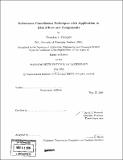| dc.contributor.advisor | David J. Perreault. | en_US |
| dc.contributor.author | Pierquet, Brandon J. (Brandon Joseph) | en_US |
| dc.contributor.other | Massachusetts Institute of Technology. Dept. of Electrical Engineering and Computer Science. | en_US |
| dc.date.accessioned | 2007-07-18T13:11:32Z | |
| dc.date.available | 2007-07-18T13:11:32Z | |
| dc.date.copyright | 2006 | en_US |
| dc.date.issued | 2006 | en_US |
| dc.identifier.uri | http://hdl.handle.net/1721.1/37923 | |
| dc.description | Thesis (S.M.)--Massachusetts Institute of Technology, Dept. of Electrical Engineering and Computer Science, 2006. | en_US |
| dc.description | Includes bibliographical references (p. 85-87). | en_US |
| dc.description.abstract | Inherent parasitic effects in passive circuit components, such as the equivalent parallel capacitance of magnetic windings and the equivalent series inductance (ESL) of capacitors, become dominant factors limiting the attenuation of high frequency signals in power filter networks. These limitations have generated recent interest in methods for compensating or mitigating parasitics to increase filter performance, including the use of coupled magnetic windings to cancel the effects of capacitor parasitic inductance. The use of these inductance cancellation windings allows for a reduction in filter volume and cost and/or an increase in its attenuation performance. This thesis extends the efficacy of inductance cancellation techniques by enhancing the manufacturability and usability of self-contained integrated filter elements, and by more effectively addressing cancellation in common- and differential-mode filter topologies, such as those designed for reducing electromagnetic interference (EMI). A design methodology and fabrication process is presented for packaging a capacitor and matched inductance cancellation winding together to create a self-contained integrated filter element. | en_US |
| dc.description.abstract | (cont.) Experimental results from the creation of three independent designs clearly illustrate the high level of performance and repeatability that is achievable. Discrete magnetic windings are used to implement inductance cancellation in filter topologies designed to attenuate both common- and differential-mode signals. The number of capacitors required for even simple designs motivate the use of a single cancellation winding for two capacitors. An analytical model along with extensive experimental results successfully demonstrate. This approach is demonstrated in an adaptation of a commercially-available EMI filter. | en_US |
| dc.description.statementofresponsibility | by Brandon J. Pierquet. | en_US |
| dc.format.extent | 87 p. | en_US |
| dc.language.iso | eng | en_US |
| dc.publisher | Massachusetts Institute of Technology | en_US |
| dc.rights | M.I.T. theses are protected by copyright. They may be viewed from this source for any purpose, but reproduction or distribution in any format is prohibited without written permission. See provided URL for inquiries about permission. | en_US |
| dc.rights.uri | http://dspace.mit.edu/handle/1721.1/7582 | |
| dc.subject | Electrical Engineering and Computer Science. | en_US |
| dc.title | Inductance cancellation techniques with application to EMI filters and components | en_US |
| dc.type | Thesis | en_US |
| dc.description.degree | S.M. | en_US |
| dc.contributor.department | Massachusetts Institute of Technology. Department of Electrical Engineering and Computer Science | |
| dc.identifier.oclc | 135440203 | en_US |
